Gui-Song Xia
EVDI++: Event-based Video Deblurring and Interpolation via Self-Supervised Learning
Sep 10, 2025



Abstract:Frame-based cameras with extended exposure times often produce perceptible visual blurring and information loss between frames, significantly degrading video quality. To address this challenge, we introduce EVDI++, a unified self-supervised framework for Event-based Video Deblurring and Interpolation that leverages the high temporal resolution of event cameras to mitigate motion blur and enable intermediate frame prediction. Specifically, the Learnable Double Integral (LDI) network is designed to estimate the mapping relation between reference frames and sharp latent images. Then, we refine the coarse results and optimize overall training efficiency by introducing a learning-based division reconstruction module, enabling images to be converted with varying exposure intervals. We devise an adaptive parameter-free fusion strategy to obtain the final results, utilizing the confidence embedded in the LDI outputs of concurrent events. A self-supervised learning framework is proposed to enable network training with real-world blurry videos and events by exploring the mutual constraints among blurry frames, latent images, and event streams. We further construct a dataset with real-world blurry images and events using a DAVIS346c camera, demonstrating the generalizability of the proposed EVDI++ in real-world scenarios. Extensive experiments on both synthetic and real-world datasets show that our method achieves state-of-the-art performance in video deblurring and interpolation tasks.
Understanding Data Influence with Differential Approximation
Aug 20, 2025Abstract:Data plays a pivotal role in the groundbreaking advancements in artificial intelligence. The quantitative analysis of data significantly contributes to model training, enhancing both the efficiency and quality of data utilization. However, existing data analysis tools often lag in accuracy. For instance, many of these tools even assume that the loss function of neural networks is convex. These limitations make it challenging to implement current methods effectively. In this paper, we introduce a new formulation to approximate a sample's influence by accumulating the differences in influence between consecutive learning steps, which we term Diff-In. Specifically, we formulate the sample-wise influence as the cumulative sum of its changes/differences across successive training iterations. By employing second-order approximations, we approximate these difference terms with high accuracy while eliminating the need for model convexity required by existing methods. Despite being a second-order method, Diff-In maintains computational complexity comparable to that of first-order methods and remains scalable. This efficiency is achieved by computing the product of the Hessian and gradient, which can be efficiently approximated using finite differences of first-order gradients. We assess the approximation accuracy of Diff-In both theoretically and empirically. Our theoretical analysis demonstrates that Diff-In achieves significantly lower approximation error compared to existing influence estimators. Extensive experiments further confirm its superior performance across multiple benchmark datasets in three data-centric tasks: data cleaning, data deletion, and coreset selection. Notably, our experiments on data pruning for large-scale vision-language pre-training show that Diff-In can scale to millions of data points and outperforms strong baselines.
Cross-View Localization via Redundant Sliced Observations and A-Contrario Validation
Aug 07, 2025



Abstract:Cross-view localization (CVL) matches ground-level images with aerial references to determine the geo-position of a camera, enabling smart vehicles to self-localize offline in GNSS-denied environments. However, most CVL methods output only a single observation, the camera pose, and lack the redundant observations required by surveying principles, making it challenging to assess localization reliability through the mutual validation of observational data. To tackle this, we introduce Slice-Loc, a two-stage method featuring an a-contrario reliability validation for CVL. Instead of using the query image as a single input, Slice-Loc divides it into sub-images and estimates the 3-DoF pose for each slice, creating redundant and independent observations. Then, a geometric rigidity formula is proposed to filter out the erroneous 3-DoF poses, and the inliers are merged to generate the final camera pose. Furthermore, we propose a model that quantifies the meaningfulness of localization by estimating the number of false alarms (NFA), according to the distribution of the locations of the sliced images. By eliminating gross errors, Slice-Loc boosts localization accuracy and effectively detects failures. After filtering out mislocalizations, Slice-Loc reduces the proportion of errors exceeding 10 m to under 3\%. In cross-city tests on the DReSS dataset, Slice-Loc cuts the mean localization error from 4.47 m to 1.86 m and the mean orientation error from $\mathbf{3.42^{\circ}}$ to $\mathbf{1.24^{\circ}}$, outperforming state-of-the-art methods. Code and dataset will be available at: https://github.com/bnothing/Slice-Loc.
Holistic Large-Scale Scene Reconstruction via Mixed Gaussian Splatting
May 29, 2025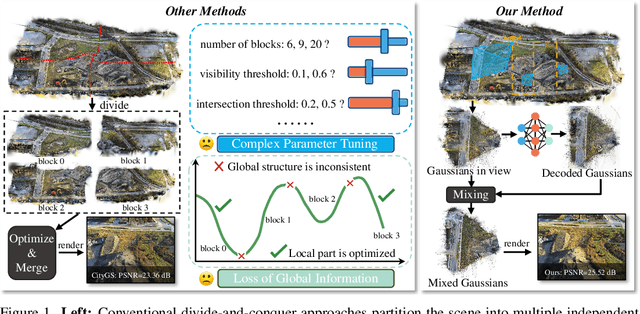
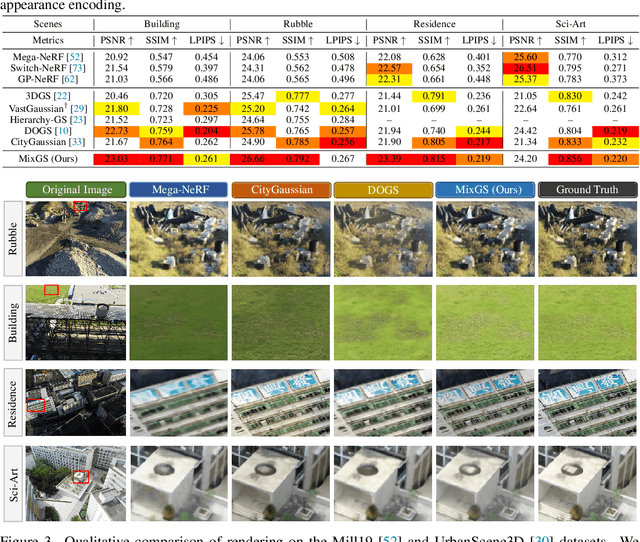
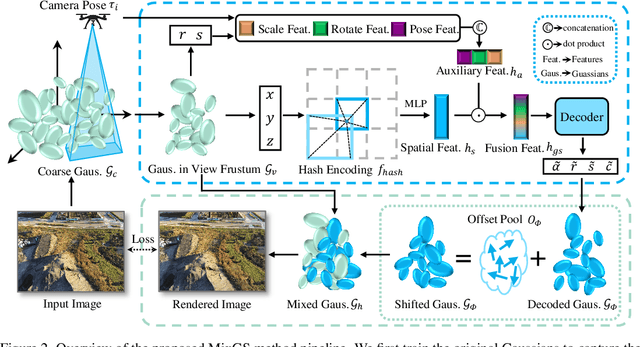
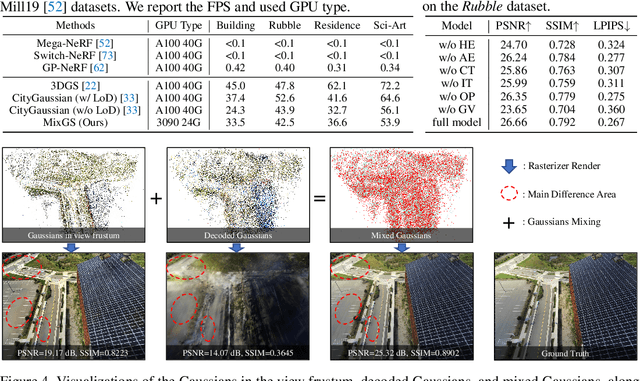
Abstract:Recent advances in 3D Gaussian Splatting have shown remarkable potential for novel view synthesis. However, most existing large-scale scene reconstruction methods rely on the divide-and-conquer paradigm, which often leads to the loss of global scene information and requires complex parameter tuning due to scene partitioning and local optimization. To address these limitations, we propose MixGS, a novel holistic optimization framework for large-scale 3D scene reconstruction. MixGS models the entire scene holistically by integrating camera pose and Gaussian attributes into a view-aware representation, which is decoded into fine-detailed Gaussians. Furthermore, a novel mixing operation combines decoded and original Gaussians to jointly preserve global coherence and local fidelity. Extensive experiments on large-scale scenes demonstrate that MixGS achieves state-of-the-art rendering quality and competitive speed, while significantly reducing computational requirements, enabling large-scale scene reconstruction training on a single 24GB VRAM GPU. The code will be released at https://github.com/azhuantou/MixGS.
Seeing through Satellite Images at Street Views
May 22, 2025Abstract:This paper studies the task of SatStreet-view synthesis, which aims to render photorealistic street-view panorama images and videos given any satellite image and specified camera positions or trajectories. We formulate to learn neural radiance field from paired images captured from satellite and street viewpoints, which comes to be a challenging learning problem due to the sparse-view natural and the extremely-large viewpoint changes between satellite and street-view images. We tackle the challenges based on a task-specific observation that street-view specific elements, including the sky and illumination effects are only visible in street-view panoramas, and present a novel approach Sat2Density++ to accomplish the goal of photo-realistic street-view panoramas rendering by modeling these street-view specific in neural networks. In the experiments, our method is testified on both urban and suburban scene datasets, demonstrating that Sat2Density++ is capable of rendering photorealistic street-view panoramas that are consistent across multiple views and faithful to the satellite image.
Vision-Language Modeling Meets Remote Sensing: Models, Datasets and Perspectives
May 20, 2025Abstract:Vision-language modeling (VLM) aims to bridge the information gap between images and natural language. Under the new paradigm of first pre-training on massive image-text pairs and then fine-tuning on task-specific data, VLM in the remote sensing domain has made significant progress. The resulting models benefit from the absorption of extensive general knowledge and demonstrate strong performance across a variety of remote sensing data analysis tasks. Moreover, they are capable of interacting with users in a conversational manner. In this paper, we aim to provide the remote sensing community with a timely and comprehensive review of the developments in VLM using the two-stage paradigm. Specifically, we first cover a taxonomy of VLM in remote sensing: contrastive learning, visual instruction tuning, and text-conditioned image generation. For each category, we detail the commonly used network architecture and pre-training objectives. Second, we conduct a thorough review of existing works, examining foundation models and task-specific adaptation methods in contrastive-based VLM, architectural upgrades, training strategies and model capabilities in instruction-based VLM, as well as generative foundation models with their representative downstream applications. Third, we summarize datasets used for VLM pre-training, fine-tuning, and evaluation, with an analysis of their construction methodologies (including image sources and caption generation) and key properties, such as scale and task adaptability. Finally, we conclude this survey with insights and discussions on future research directions: cross-modal representation alignment, vague requirement comprehension, explanation-driven model reliability, continually scalable model capabilities, and large-scale datasets featuring richer modalities and greater challenges.
Rejoining fragmented ancient bamboo slips with physics-driven deep learning
May 13, 2025



Abstract:Bamboo slips are a crucial medium for recording ancient civilizations in East Asia, and offers invaluable archaeological insights for reconstructing the Silk Road, studying material culture exchanges, and global history. However, many excavated bamboo slips have been fragmented into thousands of irregular pieces, making their rejoining a vital yet challenging step for understanding their content. Here we introduce WisePanda, a physics-driven deep learning framework designed to rejoin fragmented bamboo slips. Based on the physics of fracture and material deterioration, WisePanda automatically generates synthetic training data that captures the physical properties of bamboo fragmentations. This approach enables the training of a matching network without requiring manually paired samples, providing ranked suggestions to facilitate the rejoining process. Compared to the leading curve matching method, WisePanda increases Top-50 matching accuracy from 36\% to 52\%. Archaeologists using WisePanda have experienced substantial efficiency improvements (approximately 20 times faster) when rejoining fragmented bamboo slips. This research demonstrates that incorporating physical principles into deep learning models can significantly enhance their performance, transforming how archaeologists restore and study fragmented artifacts. WisePanda provides a new paradigm for addressing data scarcity in ancient artifact restoration through physics-driven machine learning.
Learning Fine-grained Domain Generalization via Hyperbolic State Space Hallucination
Apr 10, 2025Abstract:Fine-grained domain generalization (FGDG) aims to learn a fine-grained representation that can be well generalized to unseen target domains when only trained on the source domain data. Compared with generic domain generalization, FGDG is particularly challenging in that the fine-grained category can be only discerned by some subtle and tiny patterns. Such patterns are particularly fragile under the cross-domain style shifts caused by illumination, color and etc. To push this frontier, this paper presents a novel Hyperbolic State Space Hallucination (HSSH) method. It consists of two key components, namely, state space hallucination (SSH) and hyperbolic manifold consistency (HMC). SSH enriches the style diversity for the state embeddings by firstly extrapolating and then hallucinating the source images. Then, the pre- and post- style hallucinate state embeddings are projected into the hyperbolic manifold. The hyperbolic state space models the high-order statistics, and allows a better discernment of the fine-grained patterns. Finally, the hyperbolic distance is minimized, so that the impact of style variation on fine-grained patterns can be eliminated. Experiments on three FGDG benchmarks demonstrate its state-of-the-art performance.
DF-Calib: Targetless LiDAR-Camera Calibration via Depth Flow
Apr 02, 2025


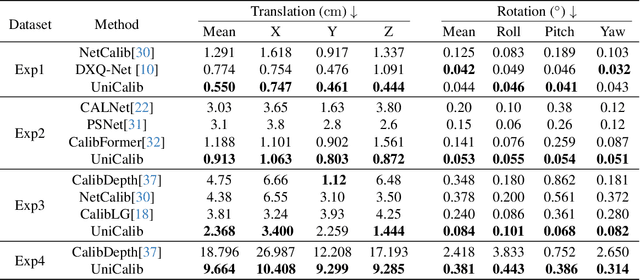
Abstract:Precise LiDAR-camera calibration is crucial for integrating these two sensors into robotic systems to achieve robust perception. In applications like autonomous driving, online targetless calibration enables a prompt sensor misalignment correction from mechanical vibrations without extra targets. However, existing methods exhibit limitations in effectively extracting consistent features from LiDAR and camera data and fail to prioritize salient regions, compromising cross-modal alignment robustness. To address these issues, we propose DF-Calib, a LiDAR-camera calibration method that reformulates calibration as an intra-modality depth flow estimation problem. DF-Calib estimates a dense depth map from the camera image and completes the sparse LiDAR projected depth map, using a shared feature encoder to extract consistent depth-to-depth features, effectively bridging the 2D-3D cross-modal gap. Additionally, we introduce a reliability map to prioritize valid pixels and propose a perceptually weighted sparse flow loss to enhance depth flow estimation. Experimental results across multiple datasets validate its accuracy and generalization,with DF-Calib achieving a mean translation error of 0.635cm and rotation error of 0.045 degrees on the KITTI dataset.
Model Hemorrhage and the Robustness Limits of Large Language Models
Mar 31, 2025



Abstract:Large language models (LLMs) demonstrate strong performance across natural language processing tasks, yet undergo significant performance degradation when modified for deployment through quantization, pruning, or decoding strategy adjustments. We define this phenomenon as model hemorrhage - performance decline caused by parameter alterations and architectural changes. Through systematic analysis of various LLM frameworks, we identify key vulnerability patterns: layer expansion frequently disrupts attention mechanisms, compression techniques induce information loss cascades, and decoding adjustments amplify prediction divergences. Our investigation reveals transformer architectures exhibit inherent robustness thresholds that determine hemorrhage severity across modification types. We propose three mitigation strategies: gradient-aware pruning preserves critical weight pathways, dynamic quantization scaling maintains activation integrity, and decoding calibration aligns generation trajectories with original model distributions. This work establishes foundational metrics for evaluating model stability during adaptation, providing practical guidelines for maintaining performance while enabling efficient LLM deployment. Our findings advance understanding of neural network resilience under architectural transformations, particularly for large-scale language models.
 Add to Chrome
Add to Chrome Add to Firefox
Add to Firefox Add to Edge
Add to Edge